#browngirlsgang
The “Saptamatrikas” (Seven Mothers) are a group of goddesses depicted together & worshipped as the source of power (shakti) to several major deities. They helped originate the concept of feminine creative power and are known for being goddesses of war and emancipation. They aide in the fight against evil and are known for their inauspicious qualities. The Matrikas series reimagines these goddesses in the modern world, with an emphasis on fashion.
From top to bottom:
1.“Kaumari”: Goddess of war. She rides a peacock and is shown with 4 arms holding various objects such as a bow, spear, axe, and coins.
2. “Maheshwari”: Maheshwari rides a bull & represents the power of transformation.
3.“Vaishnavi”: Goddess of protection & restoration. She is seen riding an eagle with hands in the Varada mudra position (lower right hand). This hand position is the “blessings” hand gesture.
4. “Chamunda”: Chamunda is the power of goddess Chandi. She is said to be ferocious by nature and inaccessible because of her anger. She hates evil doers and slays them without mercy. Often associated with Kali ma, you can think of her as Kali’s lesser known little sister.
5.“Varahi”: Preserver of the Earth. She’s depicted with a boar’s head, sometimes carrying land on her tusks. She grants boons and is a regent of the Northern direction. She can also be associated as a goddess of death who rides a buffalo.
6.“Brahmani”: Goddess of creation. She’s depicted with 4 heads (like lord Brahma), yellow in color, and rides on a swan as her vehicle of choice.
7. “Indrani”: Goddess of jealousy and wrath. She’s credited for creating the concept of “Shakti” (power) & advocating feminine divine energy as the most important strength of all. She’s often associated with elephants and lions.
More behind the series on Instagram | print enquiries: [email protected]
Post link
“Mandodari”
Part 7 of ‘Desi Remix’ [Remix of Young Spartans by Edgar Degas]
Queen Mandodari was the wife of king Ravana, the antagonist from the Hindu epic, Ramayana. Ravana was a man of many flaws, but despite all of them, Mandodari was the type of women to always lead her husband towards righteousness. When Ravana kidnaps Sita, wife of Lord Rama, she advises him to return Sita back to Rama. In a fit of rage, Ravana threatens to kill Sita unless she marries him. Just as he is about to raise his weapon, Mandodari interferes, refusing to let him cause Sita any harm. She saves Sita’s life and explains the severity of Ravana’s actions by telling him that the murder of a woman is a heinous sin.
Persistent in doing what’s right, when all attempts at returning Sita peacefully fail, she’s the last person to make a final attempt at dissuading her husband from war. Despite her efforts not always being fruitful, it is the thought that counts.
As writer Dhanalakshmi Ayyer puts it:
“Her story is a reminder that the universal denigration of a group, based on the behavior of a few, cannot cloud the greatness of the individual. Mandodari defies the stereotype of this racism. She is simple, unswerving, and self-effacing, driven by the light of knowledge which gives meaning to solid materialism in an age that is shrouded by impulse, passion, and desire. She is the instrument that awakens the mind and counsels reason when irrationality becomes the core being.“
Instagram | Print Inquiries: [email protected]
Post link
“Mohini”
Part 6 of ‘Desi Remix’ series [Remix of “The Murder of Paolo & Francesca” by Joseph Noel Patton]
Mohini is the female avatar of the Hindu god Vishnu. She is known for being an enchantress and for driving lovers to madness. Her name itself is derived from the verb moha, meaning “to enchant, perplex, or disillusion” and her name as a whole translates literally to “delusion personified”.
Mohini also has a destructive side known for slaying demons. One day, she intervenes when she sees the ash demon Bhasmasura, who has the ability to turn anyone to ash by touching their head, misuse his power on the very god who granted him this ability. Upon seeing Mohini approach him, Bhasmasura is so breath taken by her that he immediately asks her to marry him. Mohini agrees, but only on the condition that he mimics her moves in a dance. As she precedes to charm him she cleverly places her hand on top of her head. So entranced, he unknowingly repeats the move and reduces himself to ashes.
Here you see a more metaphoric depiction of the 2 sides of Mohini. On one hand you see her as the enchantress, pure, seductive, and deceivingly innocent in white and on the other hand you see her as the demon slayer, ruthless and unmerciful in red.
Post link
“Gargi”
Part 5 of the ‘Desi Remix’ series [Remix of “The Last Supper” by Juan de Juanes]
Gargi Vachaknavi was an ancient Indian philosopher. From a young age she became known for her intelligence, studying the Vedas and other philosophical scriptures with great proficiency, often surpassing men with her knowledge. One day King Janaka held a gathering, inviting all the educated sages, kings, and princes of India to participate. Janaka, also a scholar, was so impressed by the turnout of learned sages, he decided to hold a debate in search of finding a single scholar with the most knowledge about Brahman. Offering a prize of 1000 cows with golden horns, no one except sage Yajnavalkya was confident in their knowledge of the subject. Many other scholars chose not to debate with him out of uncertainty, however 8 renowned sages decided to challenge him, including Gargi, the only woman at the gathering.
Many of the competing sages debated with Yajnavalkya and asked him many philosophical questions, however his arguments were all too convincing, resulting in a loss for the sages. When it was finally Gargi’s turn to take up the challenge she questioned Yajnavalkya’s superiority, arguing repeatedly with him. She asked him everything from the status of human souls, to the environment, the universe, the origin of all existence, and the interconnectedness of the world. Upon her final question she asked him to define the world of the imperishable (Brahman). At this, he stopped her from questioning him any further and Gargi conceded to his superior knowledge. However, she still made it farther than anyone else at the debate and was Yajnavalkya’s toughest challenger to date. Being the only woman to outsmart a room full of men, she was honored as one of the 9 gems in King Janaka’s court.
As with all the pieces in this series, the point is to highlight stories of feminism and provide examples of non-stereotypical women that stood out for their unique definitions of strength in Indian mythology. This piece especially stands out because it made me reflect on how much we’ve had to fight for our rights as women. We’ve come so far from being viewed solely as child bearers and homemakers to career driven, educated women with opinions that matter and can change the world. We still have a ways to go, and there are still glass ceilings to be broken, but I hope the story of Gargi inspires you to never take no for an answer. And most importantly, never let any one make you feel that being a woman comes with limitations. If you choose to fight, you have the power to prevail and triumph.
Post link
“Savitri”
[Part 4 of the “Desi Remix” series // Remix of “The Kiss” by Gustav Klimt]
Savitri is so beautiful & pure, she intimidates all the men around her.
When it comes time for her to get married, no one asks for her hand, so she sets out to find her husband on her own. She goes on a pilgrimage & eventually finds Satyavan, the son of a blind king living in exile in the forest.
Although perfect in many ways, Satyavan was destined to die within a year. However, knowing this and despite many advising her against choosing Satyavan, she decides to marry him anyways.
The day Satyavan is predicted to die, Savitri accompanies him into the forest. While cutting wood, Satyavan suddenly becomes weak and falls into Savitri’s lap. Yama, the god of death, comes to take Satyavan’s soul but Savitri chases after him as he carries her husband’s soul away. When he tries to convince her to leave, instead she fires back with her wit. Yama, impressed by her speech, praises her and offers her any wish except the life of Satyavan. Thinking carefully, she first asks for her father-in-law’s sight to return, then a 100 children for her father, and finally a 100 children for her and Satyavan. Her last wish leaves Yama with a dilemma, as it would require Satyavan to be alive. However, impressed by Savitri’s dedication & determination, he changes his mind and decides to grant her any wish, including Satyavan’s life. She instantly asks for his life back & Yama blesses Savitri’s life with eternal happiness.
As with all the women of this series, Savitri is another example of beauty beyond the physical. Her words have their own strength & she proves that there is power in action. She defies all “damsel in distress” storylines of mythology & ironically turns them upside down to stand up for a man. If “herstory” exists, it’s because of women like this.
Post link
“Visha Kanyas”
For part 3 of the desi remix series I chose to illustrate“Visha Kanyas” (poisonous damsels). These young women were used as assassins against kings and other powerful enemies. They were often sent by kings to kill their enemies by seduction and giving their targets poisoned alcohol. It was believed that their blood was extremely poisonous to humans, and that even a single look or touch could kill a person.
“Visha Kanyas” is a remix of “Hylas and the Nymphs” by John Williams Waterhouse, in which Hylas (the companion of Greek God Hercules) is abducted by water nymphs.
Part of my goal is to easternize western paintings, but my main goal with these remixes isn’t necessarily to highlight religion or to make religious iconography. I see a lot of young desi women trying to rebel against traditional images of how desis have been depicted in the past and how they should look in order to create a new image of what modern desi women look and feel like today. I definitely support this notion, however instead of using my paintings to create a single snapshot of what the modern desi looks like, or instead of rebelling against my culture in any way, I’d rather create a scene that shows women taking action. I don’t want to make portraits to suggest that how I paint someone is what I believe beauty should look like because then the conversation becomes just about what we look like on the outside. I make paintings rooted in mythology because it tells a story of women doing things their way and being powerful. So much of history in Indian mythology is about men fighting epic battles, but you don’t hear enough about HERstory. I want to show examples from our past to prove that not all traditionally depicted women are weak, shy, or whatever other stereotypes give us negative sentiments about who we are as Indian women today. The point is that there are stories to be told that show action, not just questions about beauty captured in a single way. Whether this power comes through women defeating men by trickery, using seduction to get what they want, or going as far as killing men, these stories all show women having the upper hand, which if you ask me, defies stereotypes just as much as being a “rebel” or changing up our looks.
Post link

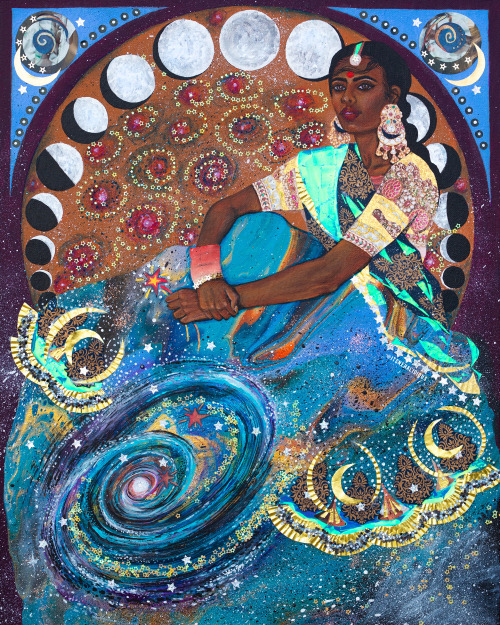

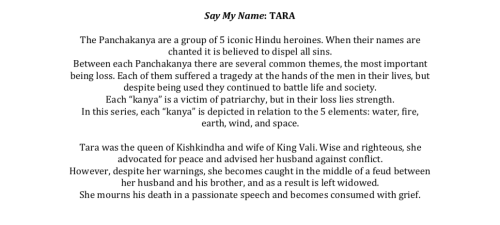

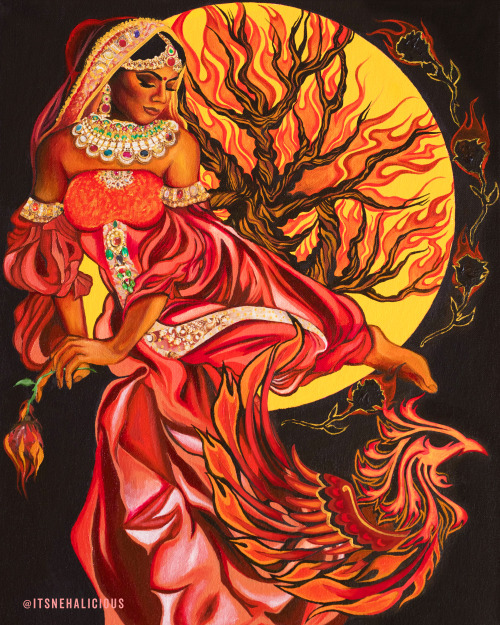


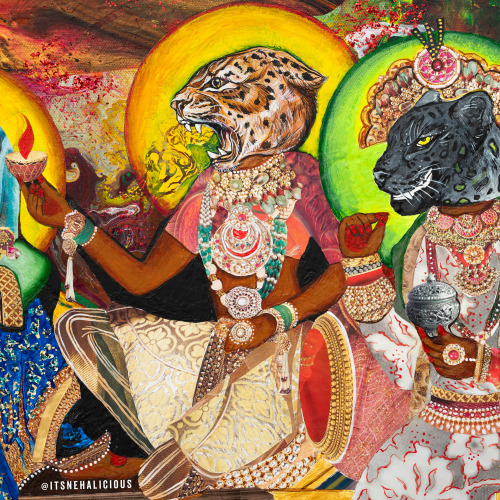
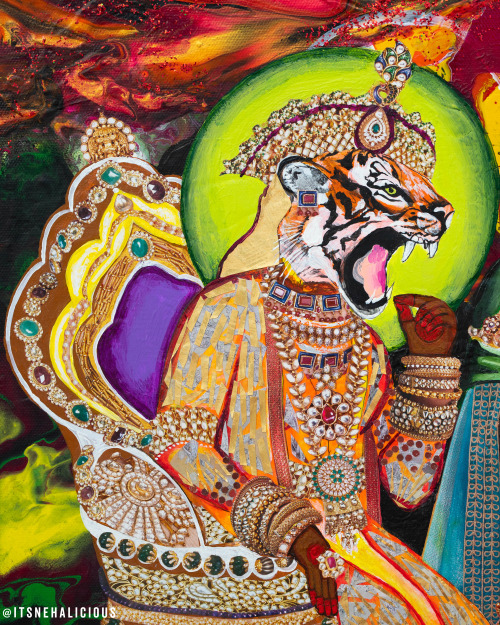

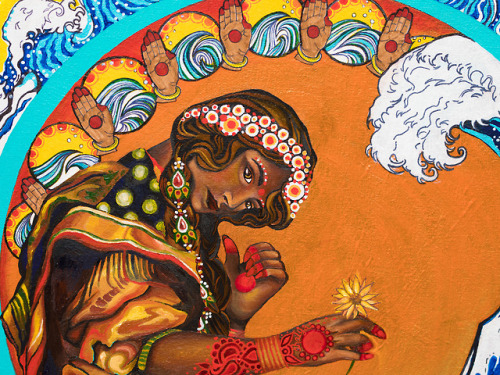
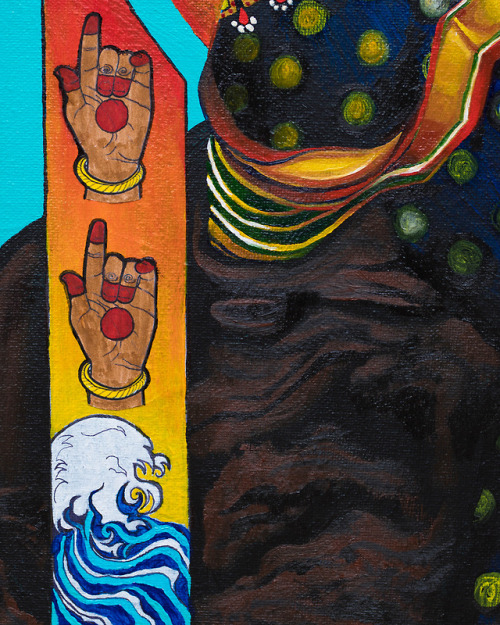


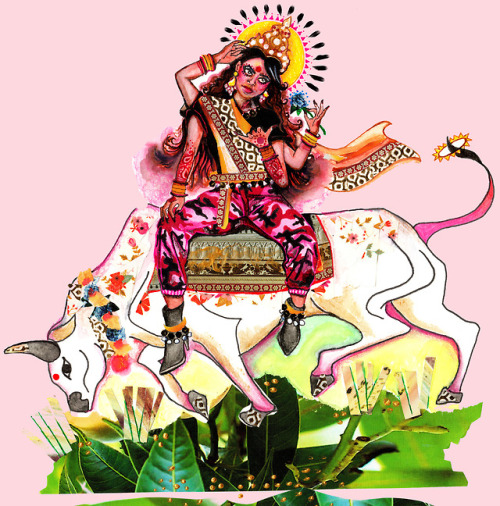
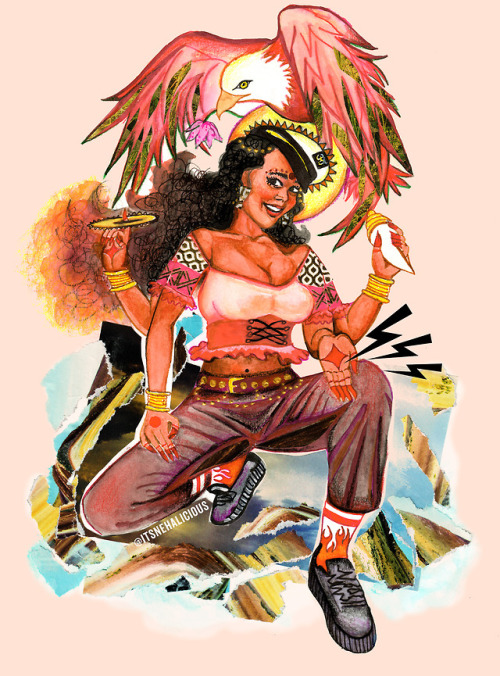

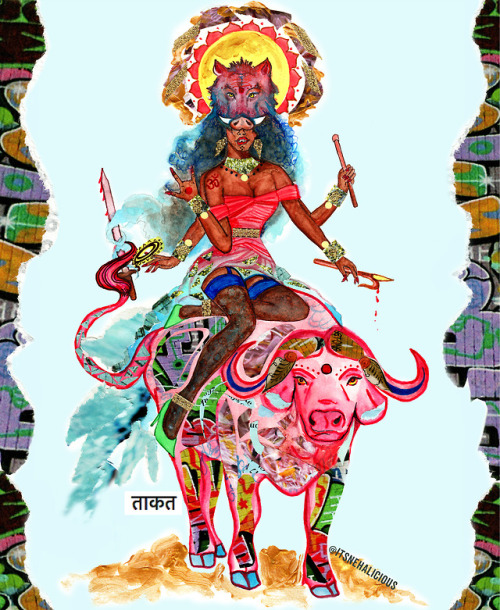
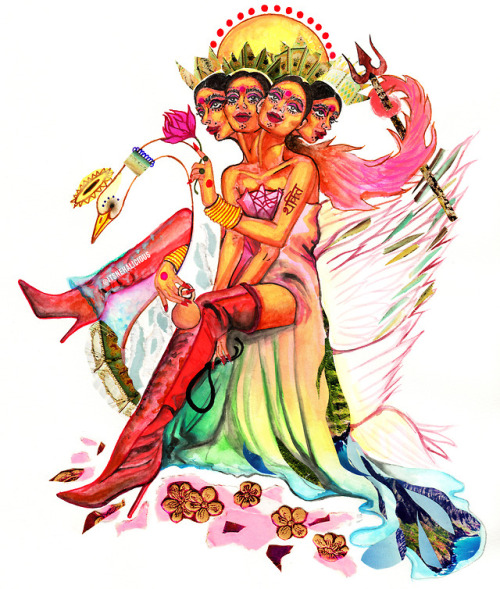



![“Mandodari” Part 7 of ‘Desi Remix’ [Remix of Young Spartans by Edgar Degas]Queen Mandodari was the w “Mandodari” Part 7 of ‘Desi Remix’ [Remix of Young Spartans by Edgar Degas]Queen Mandodari was the w](https://64.media.tumblr.com/8d608f923327c9801dab94ac7560e500/tumblr_ozmtpwp6da1s2xw6vo1_500.jpg)
![“Mandodari” Part 7 of ‘Desi Remix’ [Remix of Young Spartans by Edgar Degas]Queen Mandodari was the w “Mandodari” Part 7 of ‘Desi Remix’ [Remix of Young Spartans by Edgar Degas]Queen Mandodari was the w](https://64.media.tumblr.com/358ab2a888221dfb10d77c583ed005bf/tumblr_ozmtpwp6da1s2xw6vo2_500.jpg)
![“Mandodari” Part 7 of ‘Desi Remix’ [Remix of Young Spartans by Edgar Degas]Queen Mandodari was the w “Mandodari” Part 7 of ‘Desi Remix’ [Remix of Young Spartans by Edgar Degas]Queen Mandodari was the w](https://64.media.tumblr.com/ef466b91650c763c152b6b55c3193816/tumblr_ozmtpwp6da1s2xw6vo3_500.jpg)
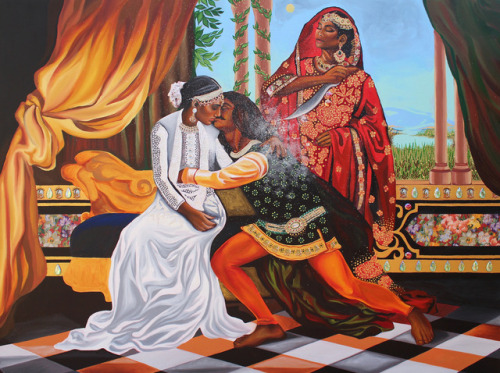
![“Gargi”Part 5 of the ‘Desi Remix’ series [Remix of “The Last Supper” by Juan de Juanes]Gargi Vachakn “Gargi”Part 5 of the ‘Desi Remix’ series [Remix of “The Last Supper” by Juan de Juanes]Gargi Vachakn](https://64.media.tumblr.com/93ce963180f17d67a59e026636f6a3fa/tumblr_ol4mkjupqo1s2xw6vo1_500.jpg)
![“Savitri” [Part 4 of the “Desi Remix” series // Remix of “The Kiss” by Gustav Klimt] Savitri is so b “Savitri” [Part 4 of the “Desi Remix” series // Remix of “The Kiss” by Gustav Klimt] Savitri is so b](https://64.media.tumblr.com/6041c82b32847b1ab7738e58d0cd8be7/tumblr_oeh6qlYh621s2xw6vo1_500.jpg)
